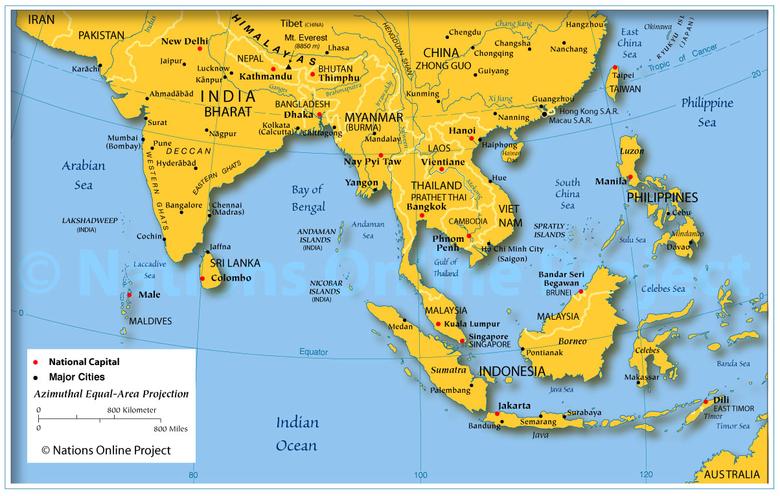
RUSSIA: I'M BACK

According to WSJ, Russia is rebuilding its profile across Southeast Asia with new diplomacy, naval exercises and deals in arms and energy, as it tries to diversify its trading partners and renew its sway in the Pacific.
Moscow is struggling with lower energy prices and Western economic sanctions that have dragged its economy into recession, spurring it to embrace anew a region where the influence of the U.S., China and Japan run deep.
The Association of Southeast Asian Nations' 10 fast-growing members, with a combined $2.6 trillion economy, dire energy needs and rising military budgets, are a prime market for Russia's top exports: hydrocarbons, energy technology and weapons.
Russian President Vladimir Putin in May signaled the new thrust by hosting the first summit of Southeast Asian nations on Russian soil, setting the stage for new business and trade deals.
"You're starting to see not just trade deals but also military security participation and presence, and the multilateral engagement too," said Matthew Sussex, a Russia specialist at the Australian National University. "What you're seeing now is evidence that Russia is serious."
The Soviet Union reached the height of its Pacific naval power in the late 1980s, deploying two aircraft carriers and more submarines to the region than the U.S. and Japan combined. It kept its largest overseas military base in Vietnam. Following the Soviet Union's dissolution in the 1990s it pulled back world-wide.
Now, Russia is resurrecting military ties in Southeast Asia and the broader region. Russia is "pushing a bit harder these days, because of the economic crisis," said Ian Storey, a senior fellow at the Iseas Yusof Ishak Institute in Singapore.
Moscow took part in both Indonesia-led Komodo military exercises, in 2014 and in April. In the past two years, it has returned to Vietnam's Cam Ranh military installation, gaining docking privileges, using its air base to fly refueling tankers into the Pacific and helping Vietnam build a submarine base there. Late last year it introduced a new class of nuclear ballistic-missile submarines to the region.
Adm. Harry B. Harris Jr., commander of the U.S. Pacific Command, told a Senate panel this year these and other advances across the Asia-Pacific region represent "an increasingly revanchist and assertive Russia." The new submarines, he said, signal "the seriousness with which Moscow views this region."
As tensions have risen with Beijing over territorial claims in the South China Sea, and over illegal fishing and piracy elsewhere in the region, military spending in Indonesia, Singapore, Thailand, Malaysia and the Philippines reached record levels in 2015, according to the Stockholm International Peace Research Institute, which tallies world-wide arms sales.
Russia satisfied much of that new demand. In the five-year period through 2015, Russian arms sales to Southeast Asia more than doubled to nearly $5 billion from the preceding five-year period. In that same time frame, the region accounted for 15% of all Russian arms exports, up from 6%.
On the trade front, a Moscow-led group of former Soviet states concluded a free-trade deal last year with Vietnam. It is now pushing to include the whole Asean bloc, where Russia accounts for a mere 1% of regional trade.
"There is so much Russia has to do to catch up with the other players," said Anton Tsvetov, a spokesman for the Russian International Affairs Council, a think tank founded by the Russian ministries of foreign affairs and education.
Veronika Novoseltseva, a counselor at the Russian Embassy in Jakarta, said ties between her country and the region are "on the move now" and becoming "much more detailed and much more concrete in various spheres." She said a new wave of Russian businesses in Indonesia, Southeast Asia's biggest economy, are shifting from a past focus on agriculture and raw goods to high-tech ventures such as air navigation and satellites.
"Never forget that two-thirds of Russia is the Asian region," Ms. Novoseltseva said. "Russia can't be excluded from developments" in the region.
In Indonesia, Russian state-controlled Rosneft is studying a joint venture to build a $14 billion oil refinery it hopes would create a new market for Russian crude and draw Indonesia investment to Russian oil fields. Rosneft also recently said it created a local venture in Singapore to design offshore oil rigs.
Another Russian state-owned firm, Rosatom, is developing the region's first nuclear reactors, in Vietnam, Moscow's closest ally. The company says it is also in talks with Cambodia, Thailand, Myanmar, Laos and Indonesia on nuclear ventures.
Some investment prospects are heading the other way. Charoen Pokphand Group, Thailand's largest agribusiness, says it is negotiating a joint investment with China's Banner Infant Dairy Products in a $1 billion integrated dairy complex that would be Russia's largest. Vietnamese milk producer TH Food Chain JSC says it plans to invest $500 million in dairy farms and milk processing plants in Russia.
-----
Earlier:
MALAYSIA: THE SECOND-LARGEST OF LNG
SINGAPORE: FIRST UNDERGROUND 1.47 MLN M3








